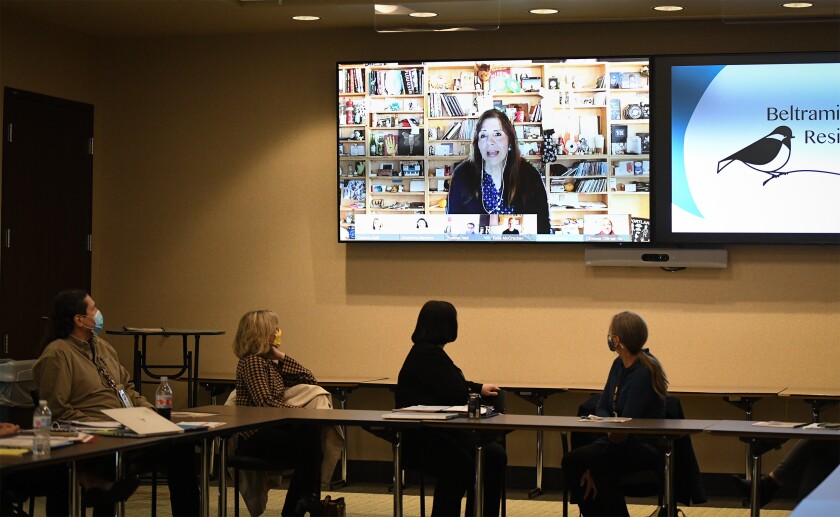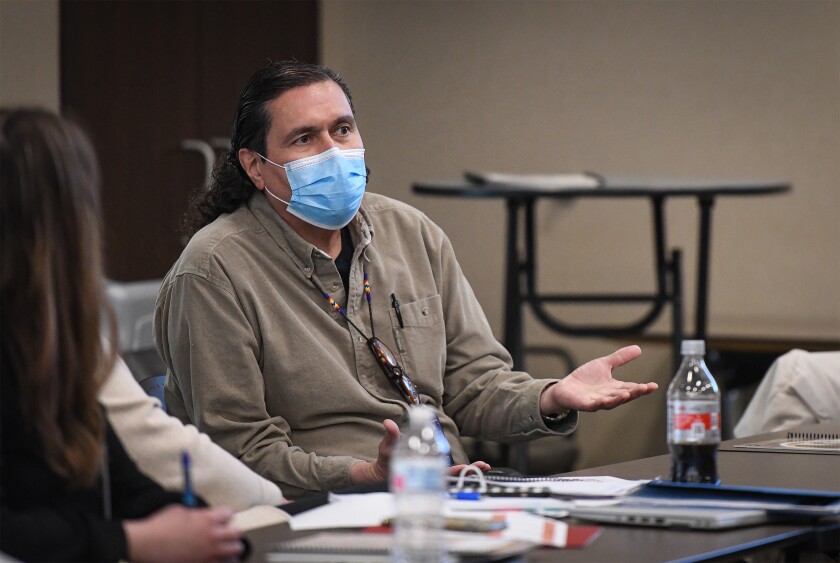BEMIDJI -- While making decisions during a community event nearly two years ago, members of the Beltrami Area Resiliency Team gazed around the room and realized major groups of Beltrami County residents werenŌĆÖt represented.
ŌĆ£It was at a community conversation about resiliency, and how we could support people's well-being,ŌĆØ Wendy Thompson, executive director of Bemidji Area Service Collaborative, said of the June 2019 meeting. ŌĆ£When those 75 or 80 people came together we looked around the room and realized whole sectors of the community were not represented.ŌĆØ
ADVERTISEMENT
She explained that it is a common issue not just in Beltrami County, but feels it is possibly a larger issue locally due to the historical trauma and poverty in the community.
ŌĆ£I think everybody was tired of coming to that conclusion, and that really challenged those of us who were going to move forward after that meeting to bring a wider network of people together,ŌĆØ she added.
Thus, the 100 Cups of Coffee project was born.
Over the past year, the Beltrami Area Resiliency Team has hosted 100 one-on-one conversations with community members sharing stories, concerns and ideas about the Bemidji community. These conversations involved 13 interview questions centered around community values, priorities, strengths, challenges and hopes for the future.
Though their project fell right in line with the pandemic and many gatherings over cups of coffee quickly turned virtual, it was successful. The final interview was completed in December and the findings were released this spring.
While the project has technically come to a close, group members say their work is far from over.
Now, the organization is going around the community presenting the results of these conversations, and inviting the public to learn from them. The team most recently spoke to Sanford Health leadership, discussing their eye-opening findings on Monday, April 26, at the Sanford Bemidji Medical Center.
ADVERTISEMENT

ŌĆ£I think anyone in our community can learn from this and kind of bring it into their sphere of influence,ŌĆØ Thompson said of the project. ŌĆ£Maybe it's your church, maybe it's your family, maybe it's your job. Maybe it's how you interact with your neighbors. Just the whole lesson here of understanding other people's stories and hearing one another as to what we could do to make our community healthier.ŌĆØ
The people behind the project
In mid-April, the Pioneer sat down with some members of the Resiliency Team who have been integral in moving this project forward.
Along with Thompson were Joseph Beaudreau, Indian Health Advocate for Sanford Health in Bemidji; Chelsea Ottman Rak from Peacemaker Resources; and Anna Carlson from the Bemidji State University Center for Sustainability Studies.
After the decision to pursue the project was made, it took time and effort before coming to fruition. Group members painstakingly planned and edited the list of interview questions.
ŌĆ£I would say about four months we kind of tinkered with how it would look if we did this in our community specifically asking the people who aren't at the policy-making table,ŌĆØ Thompson said.
ADVERTISEMENT
Twelve volunteer interviewers were trained on how to listen to the responses, and how to inform the interviewees about the project.
The interviewees -- 100 people from the area -- also volunteered their time and represented people from all walks of life in Bemidji.
The group was made up of 33 men, 66 women and one non-binary participant. Racially, the group was 50% white, 35% Indigenous, 11% Black, 2% Asian and 1% Latino. Six participants were under the age of 20, with 15 in the 20-30 age group, 27 in the 31-40 age group, 25 in the 41-50 age group, 20 in the 51-65 age group, and five were over the age of 66.
Asking the right questions
The aim of the project was to learn the goals, concerns and values of community members who may not be voicing them in a public forum. While a lot of policymakers say they welcome public input at meetings, many people may still not feel welcome in those spaces, Carlson explained.
ŌĆ£A lot of people, policymakers or people in decision-making places that want public input, have a tendency to say, ŌĆśshow up, you're always welcome at a meeting,ŌĆÖ but might not have that same perspective as this shared experience of why some people aren't showing up,ŌĆØ she said. ŌĆ£How we can rethink those invitations, and how we can start showing up at other people's tables and not just asking them to come to our spaces?ŌĆØ
The interviews started in March 2020, with the 100th interview held in late December.
Interviewers asked each participant the same set of questions, such as ŌĆ£When you need help, who do you turn to?ŌĆØ and ŌĆ£What makes you feel connected to the community?ŌĆØ
ADVERTISEMENT
The one that often garnered the most significant response, Carlson said, was ŌĆ£What is something you know that you wish others in your community knew and paid attention to?ŌĆØ
ŌĆ£That one really struck me for a couple of reasons,ŌĆØ she said. ŌĆ£Honoring that each of us has that unique knowledge and story and that we have something to tell and share.ŌĆØ
She explained that participants sharing their answers gave insight on how they could have an impact and raise awareness on specific issues.
In that question, interviewees offered their own knowledge and insights that may not be known by the wider community. The most frequently mentioned topics were:
The existence of racism.
Mental health needs in the community.
Homelessness in the community.
The need for understanding to establish empathy and common ground.
In a question asking whether participants felt like they had a voice when decisions are made in the community, more than 40% said ŌĆ£no.ŌĆØ
According to the report, interviewees overwhelmingly expressed the desire for a place for indoor recreation. Some proposed a place where one could simply exercise indoors, while others wished for a more multi-purpose space, where community members could recreate, take classes, hold events and simply gather together.
ŌĆ£DivisionŌĆØ was noted as the most significant challenge facing the community.
ADVERTISEMENT
Throughout the conversations, many also described a desire to better connect with other people, and a feeling of isolation stemming beyond the pandemic.
by on Scribd
The members of the Resiliency Team said their eyes were opened to a lot of issues through the findings of these conversations.
ŌĆ£I learned so much about the racism of our community, firsthand stories. Hearing those stories was really impactful because as much as I know that there are these undercurrents of discrimination and division and racism and prejudice,ŌĆØ Ottman Rak said, ŌĆ£to hear someone tell me a story about themselves, about their children about their experience of not feeling safe, about their experience of not wanting to go places if they're the only one that looks like them, it just has made me see the community in a completely different way.ŌĆØ
Beaudreau said due to, or even in spite of, the anonymity of the responses, he could feel their raw honesty.
ŌĆ£I just really feel appreciative of how people laid bare the things they shared with us, that they let themselves be vulnerable, and that they did share their experiences. You really have to honor that,ŌĆØ Thompson said. ŌĆ£I think although conflict and tension came up in our interviews. I also got the sense that people want connection, and that gives me a lot of hope.ŌĆØ
ADVERTISEMENT

Next steps
Thompson sees this project's culmination as more of a springboard than a bookend.
She said in these interviews, close to 90% of interviewees wanted to continue being involved with the activities of the Resiliency Team.
ŌĆ£We're planning these community presentations and inviting our interviewees to come to those and be a part of that continued conversation,ŌĆØ Thompson said. ŌĆ£We'll be presenting what they helped us find in our report, but then we'll do breakout rooms where they can continue the conversation with other community members.ŌĆØ
Now, the group is making the rounds throughout the community to present their findings to decision-makers, exploring the results of these conversations and continuing the discussion to discern what the next steps look like for our community.
One such event is taking place from noon to 2 p.m. on Wednesday, May 5, on Zoom.
If people would like to get involved with the group they can do so by reaching out on the The 100 Cups of Coffee project full report can be viewed on the website as well.










